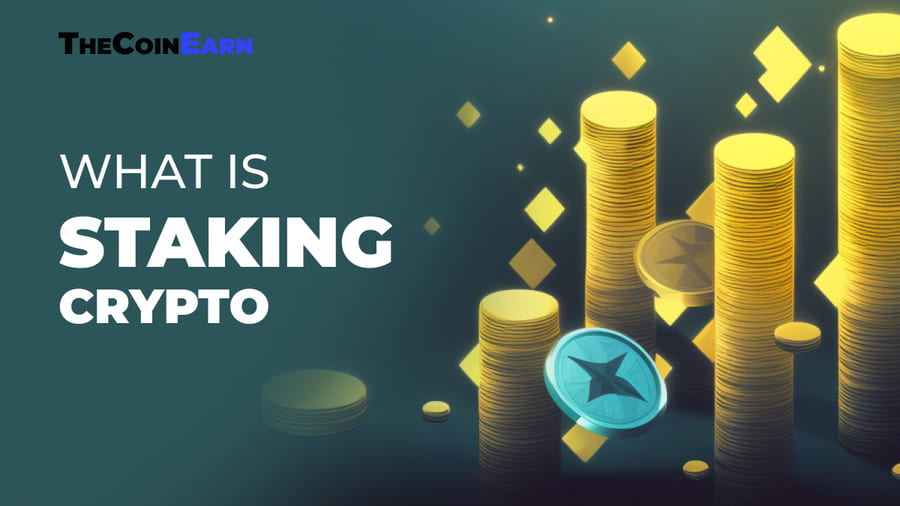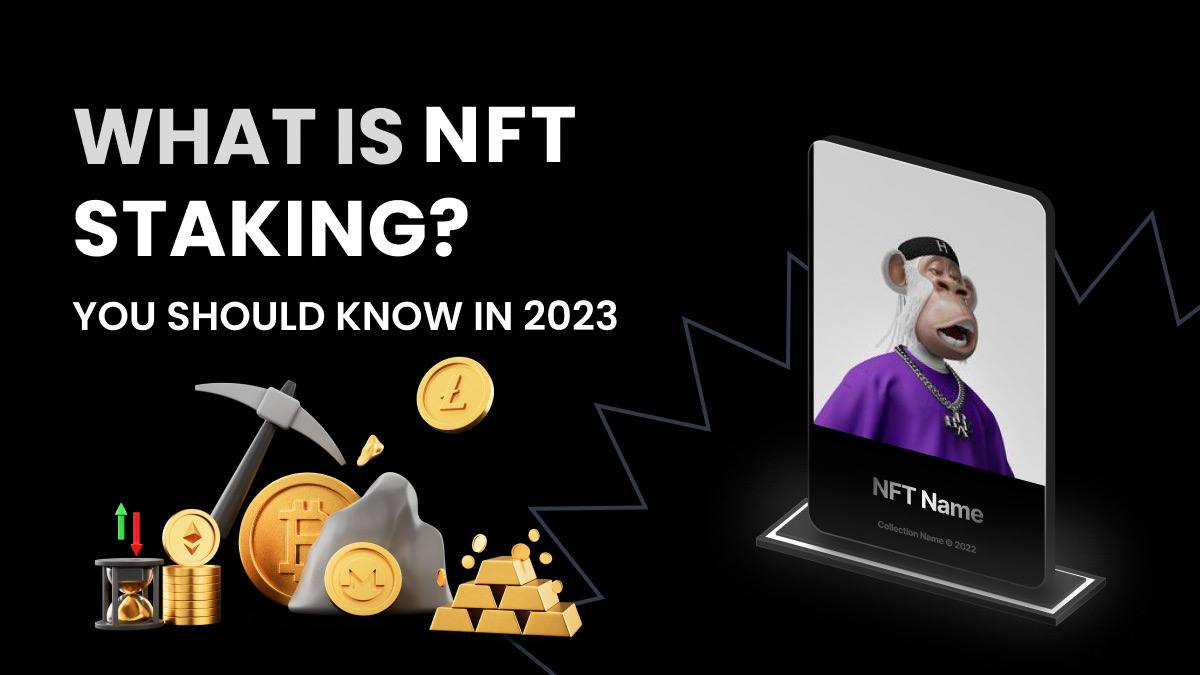If you have crypto and want to earn interest on it fairly easily, you can try staking. So you will not only receive profit but also support the work of the blockchain network. But what does it mean to stake crypto?
Put simply, staking crypto meaning a method to make your cryptocurrency work and generate passive income. This is a kind of alternative to mining but is less resource-intensive. Compared to the latter, it does not require large computer capacities or other computing equipment. Therefore, it does not require a lot of electricity. Now let's take a deeper look at what is staking in crypto, and how staking crypto works.

What is crypto staking?
Undoubtedly, there is a need to start by outlining the staking definition. Crypto staking is a tool for passive earnings on cryptocurrency storage and a way to ensure the operability of the blockchain network.
Staking crypto can be compared to a bank deposit. You store coins in a cryptocurrency wallet to keep the blockchain running. So you block a certain amount of cryptocurrency, that is, you cannot use it for a certain time.
Staking is closely related to the Proof of Stake mechanism. When using it, the principle applies: the larger the amount you save, the more blocks you have a chance to create. For each confirmed transaction - and, accordingly, creating a new block in the blockchain, - you will receive a certain number of coins (kind of reward).
You may ask: What is the purpose of staking crypto? The answer is passive income. As mentioned, crypto staking is a great way to generate passive income - you can "bet" some of your holdings and get rewarded. This is usually through a "bet pool".
How does staking work?
Now that we have figured out what staking means in crypto, let's find out how it works.
People (participants of the process) stake their coins in the cryptocurrency protocol. The protocol selects validators from these participants, that is, a node that will have the right to confirm transactions. The more coins you stake, the more likely you are to become a validator. Each time a new block is added to the blockchain, new tokens are minted and distributed as a staking reward to the validator of that block.
The reward is usually the same cryptocurrency used by the participants, although some blockchains use a different type. If you want to stake crypto, you need to own a type that uses Proof-of-Stake. Then you can choose the amount you want to deposit. This can be done with the help of such cryptocurrency exchanges as WhiteBIT, Cardano, UMI, Polkadot.
During staking, your coins stay with you. But you block them in your wallet, that is, you cannot use them for a certain time. You can stop staking if you want to sell your coins. When exactly you can pick them up depends on various factors. Some cryptocurrencies have a minimum staking process, such as three months. You cannot withdraw your funds during this time.
The main advantage of staking is the opportunity to earn more due to high-interest rates. In some cases, you can get more than 10-20% per year. Potentially, this is a pretty profitable method to invest your money.
The most efficient way to reduce costs is not to require all miners to perform energy-intensive math tasks. Instead, transactions are verified using people who invest in the blockchain through staking crypto.
Staking performs a similar function to mining, as it allows a network member to participate in adding the final batch of transactions to the blockchain and earn interest in crypto.
The exact implementation varies from project to project, but in most cases, users stake to be able to add a new block to the blockchain in exchange for a reward. Their tokens serve as a guarantee of the legitimacy of any new transaction they add.
What is the difference between staking and mining?
We found the answer to the question of what stake means in crypto, but what is mining, and what is the difference between them? Staking and mining are "consensus mechanisms", that is, algorithms for confirming transactions in the blockchain. They ensure that transactions are legitimate. For example, no one tries to spend the same coins more than once.
But there is a difference between them. Mining works on the Proof of Work protocol, where miners battle in solving cryptographic puzzles. The one who does it faster gets the right to verify the last block of transactions on the blockchain and create a new block. For this, he receives a small reward in the cryptocurrency he mines.
For mining, equipment with high computing power is used, for example, special integrated ASIC cards. Therefore, mining requires a lot of energy.
Staking works on the Proof of Stake algorithm. There are no challenges such as in mining. It is enough to have a certain amount of coins in the account. So transactions here are much faster.
Even here, the entrance threshold is much lower, because you do not need to buy powerful equipment for mining. Except for certain cryptos.
How to stake crypto?
Now I know what is staking in cryptocurrency. What's next? In general, staking is open to anyone who wants to take part. However, becoming a full-fledged validator requires some technical knowledge and investment, and a dedicated computer that can perform validation continuously day or night. It is due to security considerations and is essential, as outages can lead to a reduction in the validator's stake.
Here's where you can stake:
1. On crypto exchanges. Here you can deposit an available amount to the betting pool. This allows investors to start earning rewards without using their hardware. But keeping funds on exchanges is risky because they are sometimes hacked.
2. On staking platforms. Such crypto staking is also called soft. Stake Capital and MyCointainer are examples of such platforms.
3. On hardware wallets. It is a small device for storing cryptocurrency. From the outside, it resembles a flash drive. May have a USB connector or buttons to enter a PIN code. On hardware wallets, the crypt is more protected against hacking.
A wallet has an address, which is a specific location in the blockchain where coins can be sent. When staking crypto on hardware wallets, it is important to store coins at the same address. That is, you cannot move coins, because this way you will lose the reward for creating blocks.
Types of staking
There are several classifications of staking. For example, by the method of obtaining coins. Staking can be delegated, for example, to exchanges, or become a validator, that is, create new blocks and confirm transactions independently. With this approach, you get all the staking rewards.
Pool staking is much easier. This is usually what is meant when talking about crypto staking. You simply block your coins with a recognized validator. You get rewarded for this, and the validators will take a small percentage of your profit.
Although the first method of staking is more profitable, it is also more difficult (additional knowledge and skills are required to become an independent validator, and for some cryptocurrencies, independent staking has a high financial entry threshold). Many prefer to earn by staking through pools (especially on cryptocurrency exchanges).
To be a validator, you need:
- understand the technical details of how cryptocurrencies work;
- have enough cryptocurrency to create a new block;
- have a reliable Internet, which is used in data centers.
According to the term placement of cryptocurrencies in staking, 2 main types of staking can be distinguished
1. Fixed – when the user determines in advance for what period he gives coins for staking. For example, for three months. In this case, you cannot use cryptocurrency during the staking period, but you can get a higher return.
2. Flexible – no staking end date is specified here. That is, you can withdraw your coins at any time. Interest for staking will be accrued until you withdraw the crypto. This option is suitable for those who are used to having free access to their assets.
Advantages and risks of cryptocurrency staking
Taking into account all of the above, a logical question arises: Is staking crypto worth it? Definitely Yes. Among the main advantages of crypto staking:
- You help keep the blockchain running.
- Compared to mining, you won't need complex equipment.
- Staking is more environmentally friendly than mining because it does not require a lot of energy.
- It is much less harmful to the environment than mining.
- This is an easy way to earn interest on your cryptocurrency savings.
Though staking crypto is safe, you need to be aware that there may be some risks here as well.
Here are the risks associated with staking:
- High volatility of cryptocurrency. You can earn 10% per annum on staking, while the value of the cryptocurrency may decrease by 50% during this period.
- With fixed staking, you cannot access your cryptocurrency for a certain period.
- If you choose the flexible staking option, you will still have to wait a while to collect your coins. For example, seven days or more.
- Additional fees may apply (when transferring cryptocurrency between staking exchanges, and some exchanges charge additional fees for staking services).
- Staking exchanges can be hacked. So you will lose both the coins you staked and your reward. And since you can't ensure your assets, you most likely won't be compensated. For example, in 2021, hackers stole approximately $30 million from such an exchange.
The bottom line
Crypto staking is in many ways similar to a savings or deposit account in a bank and allows you to earn passively by storing your cryptocurrency (ideal for long-term investors), with almost no risk. It works only for those cryptocurrencies that use the Proof of Stake algorithm. However, before investing in cryptocurrency, you need to understand what is staking, how to stake cryptocurrency, what coins are best to select for this purpose, and all the benefits and risks. With the right choice of cryptocurrencies for staking (promising in terms of growth and less volatile), you can get a fairly high passive income and increase your savings every year. Because cryptos can use a consensus mechanism to process numerous transactions at minimal cost, the barrier to entry for investors is constantly lowered.
In this article, you learned what staking in cryptocurrency is, how staking crypto works, compared it with mining, and much more.


